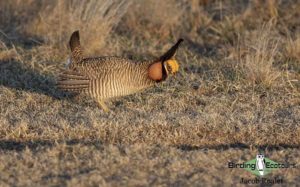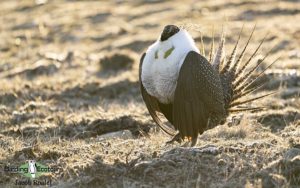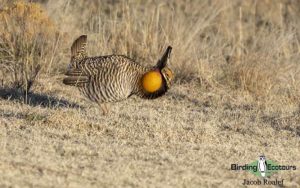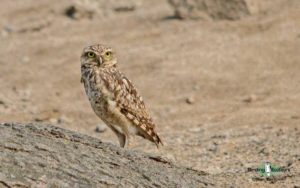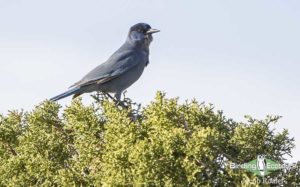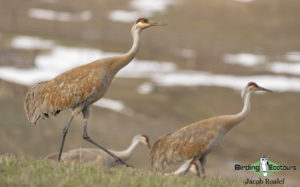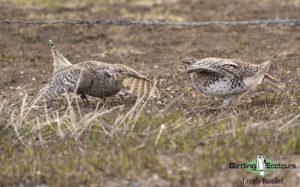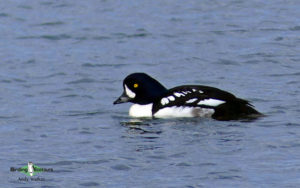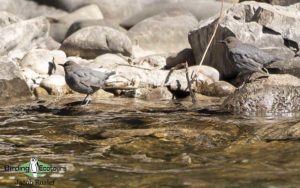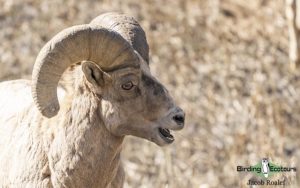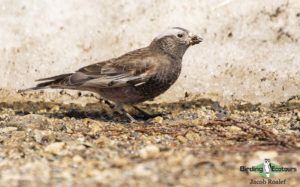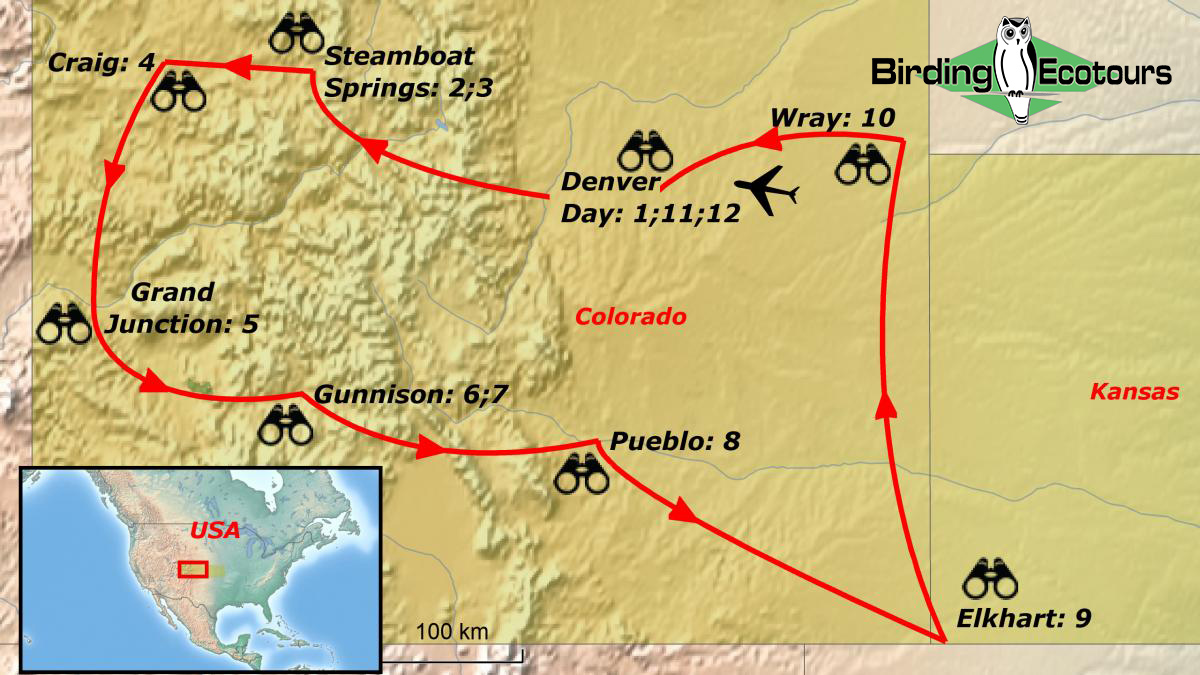Birding Tour USA: Colorado – Lekking Grouse and Rocky Mountains
Go to: USA Birding Tours | Birding Tours in North America | All our birding tours
Colorado: Lekking Grouse, Rocky Mountains, and Open Plains
April 2025/2026
Colorado offers one of the most spectacular North American birding spectacles with the spring lekking season of several grouse species including the stunning Gunnison (Sage) and (Greater) Sage Grouse and the ever declining Greater and Lesser Prairie Chickens. Churring, gurgling, prancing males strut around their chosen lek, competing with other males to see who can get selected by a mate. While this trip is a more focus “chicken run” of sorts, there are plenty of other amazing bird species to be on the lookout for. These include a nice mix of both migrants and long staying species such as Black, Grey-crowned, and Brown-capped Rosy Finches, Barrow’s Goldeneye, American Dipper, Williamson’s Sapsucker, Pinyon Jay, Bald Eagle, and the list goes on and on! Both spring and fall migration in Colorado are amazing and we time this trip perfectly for the spring leks and arrival of spring migrants on their journey to breeding grounds. Along with the amazing bird and wildlife spectacles, are the wide assortment of fantastic habitats providing jaw-dropping scenery throughout the tour. From the stunning Rocky Mountains and rolling grass prairies to the cottonwood canyons and pine forests, the trip is never lacking a stunning view along the way. This great diversity of habitats provides us a refreshing new locale each day and with it a differing bird and wildlife community. The National Audubon Society and Colorado Birding Trail do a fantastic job here to help preserve the pristine habitats and help encourage folks to get out and experience nature with their birding festival in March and other community programs.
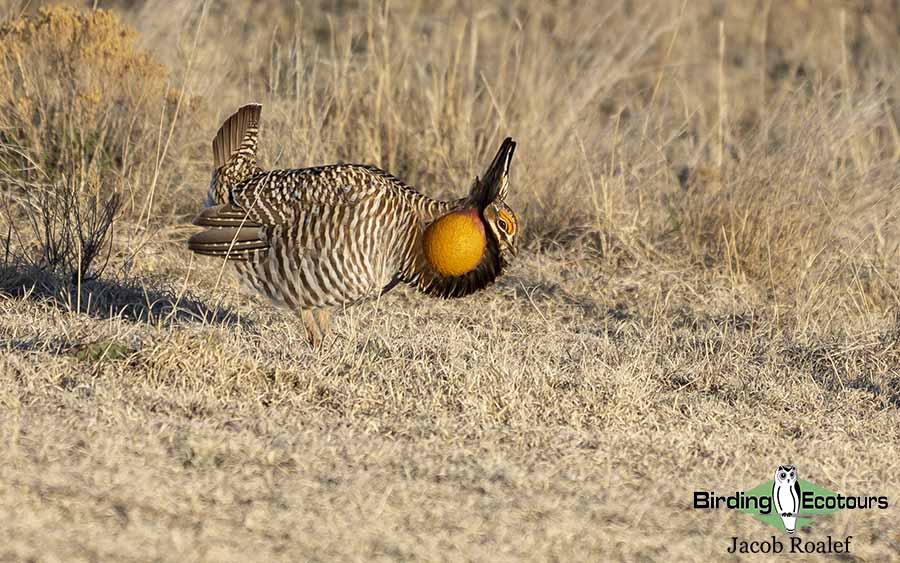
This tour begins in the mile-high city of Denver, visiting its various pristine birding locations before heading west and up into the dizzying heights of the Rocky Mountains. Up here, the search is on for the tricky White-tailed Ptarmigan and rosy finches. We continue onwards for our first few leks of the trip and then head southwest to Grand Junction and Gunnison, birding along the way in hopes of seeing treats like Mountain Bluebird and Clark’s Nutcracker. From here we head east and into the lowlands and grasslands of southeast Colorado with a brief dip into Kansas for Lesser Prairie Chicken. We complete our large “chicken loop” of Colorado in the northeast corner at the Pawnee National Grasslands, a premier birding spot, with Thick-billed and Chestnut-collared Longspurs and Mountain Plover amongst the many targets.
This trip can be combined with our Texas Spring and Whooping Cranes Tour, which immediately precedes it, and with our Florida Peninsula and Specialties Tour following it.
Due to the extremely limited availability and access to some of the leks, this itinerary is subject to run in a slightly different order while still visiting all of the locations and destinations.
Itinerary (11 days/10 nights)
Day 1. Arrival in Denver
Arrival at the Denver airport will be followed by introductions and an orientation about our upcoming trip. We will do some local birding as time allows and prepare for what will surely be a fantastic tour full of beautiful birds and scenery.
Overnight: Denver, Colorado
Day 2. Genesee, Loveland Pass, Silverthorne
Today will be jammed packed as we work our way out of Denver towards Steamboat Springs in the northwest. The morning will kick off with some birding at Genesee Mountain Park on the edge of Denver. Some of the targets here include Cassin’s Finch, Pygmy Nuthatch, Steller’s Jay, Clark’s Nutcracker, and Williamson’s Sapsucker. As we cruise through the mountains towards Loveland Pass, we will be sure to watch out for species like Mountain Bluebird, Townsend’s Solitaire, Two-barred (White-winged) and Red Crossbills. We will also keep our eyes peeled on the fast-moving rivers and streams for American Dipper. Eventually, we will make it to the Guanella Pass, our first stop in search of White-tailed Ptarmigan, before retreating from this high elevation back to the small town of Georgetown. If we do not have any luck here, we’ll take Route 6 over the summit of Loveland Pass (weather permitting) to give us another chance for the elusive White-tailed Ptarmigan. We’ll descend down the mountains to the town of Silverthorne where we will drive the roads, searching for feeders and seeds in hopes of spotting great birds including all three species of rosy-finches, Black, Grey-crowned and Brown-capped Rosy-Finch. Along Highway 9, towards Kremmling, there are some good bodies of water for ducks and open areas to scan for Prairie Falcon. We’ll have a brief stop at some of the open water areas along the way, which could yield the stunning Barrow’s Goldeneye and other great waterfowl species. Finally, we will arrive in Steamboat Springs, our home for the next two nights.
Overnight: Steamboat Springs, Colorado
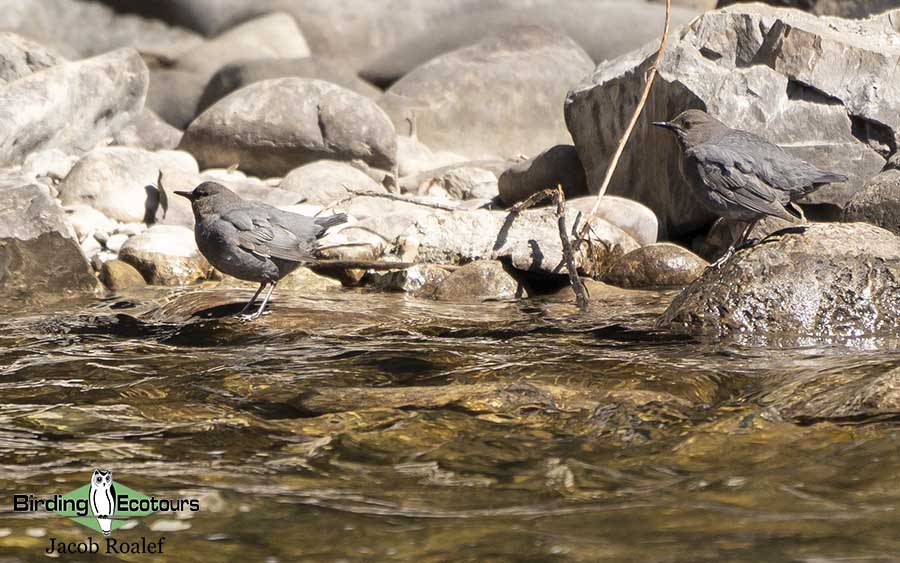
Day 3. Coalmont for Sage Grouse lek, Hayden
This morning we will get up early, grab a quick breakfast and head east to look for (Greater) Sage Grouse on their lek in the Coalmont area. Leaving early is critical to ensure we are set up before sunrise, when the birds come onto the lek. From our vehicles we’ll be able to watch the spectacle of these amazing birds strutting around, inflating air sacs, and fanning tails to attract a female. From here we’ll continue north to Walden, visiting the Delaney Butte Lakes and the Walden Reservoir in search of some wintering water birds. In the afternoon, we’ll retrace our steps west, birding to Hayden for our first chance to spot Sharp-tailed and Dusky Grouse. After dinner, it is back to the hotel for the evening in Steamboat Springs.
Overnight: Steamboat Springs, Colorado
Day 4. Hayden, Black Mountain, Grand Junction
We’ll start the day with a check of the Sharp-tailed Grouse lek. We should be able to park off the road and get a good look at these birds lekking away in the morning. From here, we’ll head north of Craig to Black Mountain in the Routt National Forest, checking for American Three-toed Woodpecker and Dusky Grouse lekking in the road. We’ll continue south from Craig onto Route 13, looking for waterfowl along the way, especially Cinnamon Teal. At Meeker, we’ll head west towards Rio Blanco Lake to check for loons and other waterfowl, and then drive south along Route 5 through this wonderful wilderness area, checking for birds along the way. Just north of Rifle, we’ll rejoin Route 13 and make a quick stop at the Fravert Reservoir to look for Pinyon Jay, Juniper Titmouse and Bewick’s Wren. There is a good pond here that hosts a variety of waterfowl and both Red-winged and Yellow-headed Blackbirds. We might see White-throated Swift flying about as well. At Coal Creek Canyon, we’ll pass the Cameo power plant and head into open juniper country, where we get a chance to look for Chukar Partridge, Say’s Phoebe, Rock Wren, and Black-throated Sparrow. We’ll make it to Grand Junction for dinner and our hotel for the evening.
Overnight: Grand Junction, Colorado
Day 5. Grand Junction, Blue Mesa Reservoir, Crested Butte
We start the day with the breath-taking views from Colorado National Monument. Just a few of the target birds here include Gambel’s Quail, Juniper Titmouse, Western and Mountain Bluebirds, and a possibility for American Grey Flycatcher. We’ll check a few of the local reservoirs near Delta for Western and Clark’s Grebes along with a bevy of ducks, and we’ll also scout the cattails for rails and Marsh Wren. Then we proceed to the Black Canyon of the Gunnison National Park’s Rim Drive road. Here, we have another chance to find Dusky Grouse, sometimes seen displaying atop picnic tables! This road offers outstanding views of the canyon. We’ll make our way on the South Rim Drive to the visitor center for some great looks at the canyon. While we may have already seen these species elsewhere, other possibilities here include Golden Eagle, Woodhouse’s Scrub Jay, Violet-green Swallow, Clark’s Nutcracker and Green-tailed Towhee. We’ll also need to keep our eyes open for some amazing mammals such as Mule Deer, Bobcat, Grey Fox and Yellow-bellied Marmot. Our final main destination for the day is the Blue Mesa Reservoir. This area may hold lots of waterfowl, some gulls (American Herring and possibly California Gulls), shorebirds, Barrow’s Goldeneye, Sage Thrasher, and Vesper Sparrow. Get to bed early tonight in preparation for our early start to Day 6!
Overnight: Gunnison, Colorado
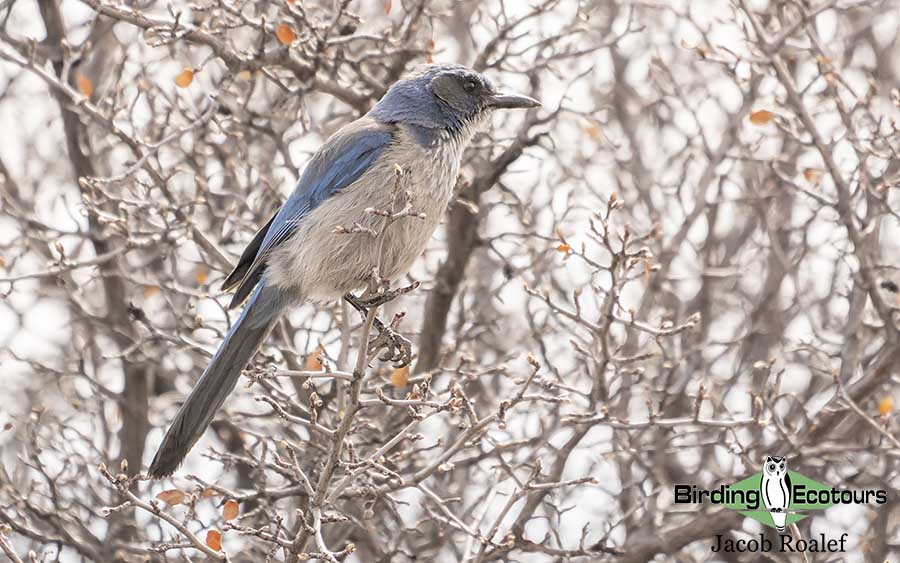
Day 6. Gunnison
Today we will head for the Endangered (IUCN) Gunnison (Sage) Grouse lek. Things you need to know: we will be departing the hotel around 4:45 a.m. as we must be parked and set an hour before sunrise, as the birds get there quite early. Once at the viewing area, there is no leaving the cars (no bathroom breaks!) until the birds are finished with their displays, perhaps three hours after sunrise. No morning coffee! There is a simple bathroom at the site, and we should be able to use it upon initial arrival and at the end. Also expect cold temperatures. Over the past years, low temps have ranged from 22 to 33 degrees Fahrenheit (-5 to 0 Celsius). We’ll be going back to the hotel after we leave here – you may want to sneak out a blanket or two. Hand and foot warmer packets are always a good idea as well. No flash photography is allowed here either. Other species we may see while enjoying the grouse are Swainson’s Hawk, Horned Lark, Western Meadowlark, Brewer’s Blackbird and maybe a Gunnison’s Prairie Dog. After a late breakfast, we’ll drive to Crested Butte to check for rosy finches. These rosy finches are all based on snow. If it is snowing in the mountains, it will bring the finches down to the feeders. Otherwise, there is only a low chance of seeing them, so, we will keep an eye on the weather forecast. We’ll spend a couple of hours up here checking local feeders and have some lunch before driving back to Gunnison. In Gunnison there are a few areas to check for Great Horned Owl, Black-billed Magpie, Lewis’s Woodpecker, Townsend’s Solitaire and others, before retiring back to our accommodation for the night.
Overnight: Gunnison, Colorado
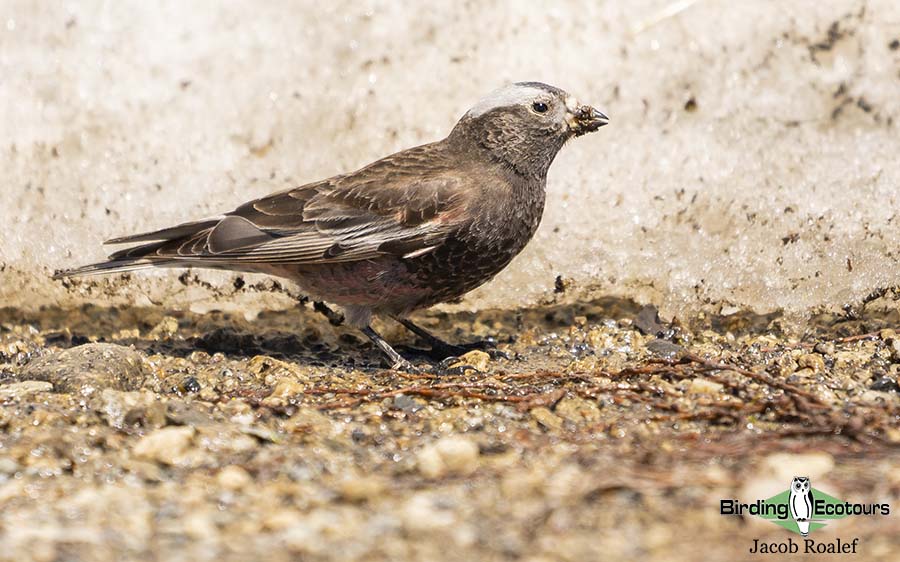
Day 7. Gunnison to Pueblo
If we had no luck with the Gunnison (Sage) Grouse the day before, we can rise early and try again, but if we did have luck we will head east towards Pueblo. On the road to Pueblo, we will stop for birding at Monarch Pass to look for more mountain bird species. There is a parking lot from which you will see some unbelievable scenery. As we descend the east side, we will keep an eye out for Clark’s Nutcracker and Band-tailed Pigeon. Other stops along the route will be where there are open rivers – to look for American Dipper. Bighorn Sheep are a possibility as well. Next, we will make a couple of nice stops on Cañon City Tunnel Drive for a chance at Rufous-crowned Sparrow, Rock Wren, Canyon Wren, and Black Phoebe. Cañon City River Walk has some nice riparian habitat for a large variety of birds like Western Bluebird, Lesser Goldfinch and the red-shafted morph of Northern Flicker. This is a great place to eat if the weather is good. After lunch, we’ll continue east to a dry scrub area and the Pueblo Reservoir. Some of our target birds include Scaled Quail, Burrowing Owl, Loggerhead Shrike, Juniper Titmouse, American Bushtit, Curve-billed Thrasher, and Canyon Towhee. We could also see some species of gulls and water birds at the reservoir before settling into Pueblo for the night.
Overnight: Pueblo, Colorado
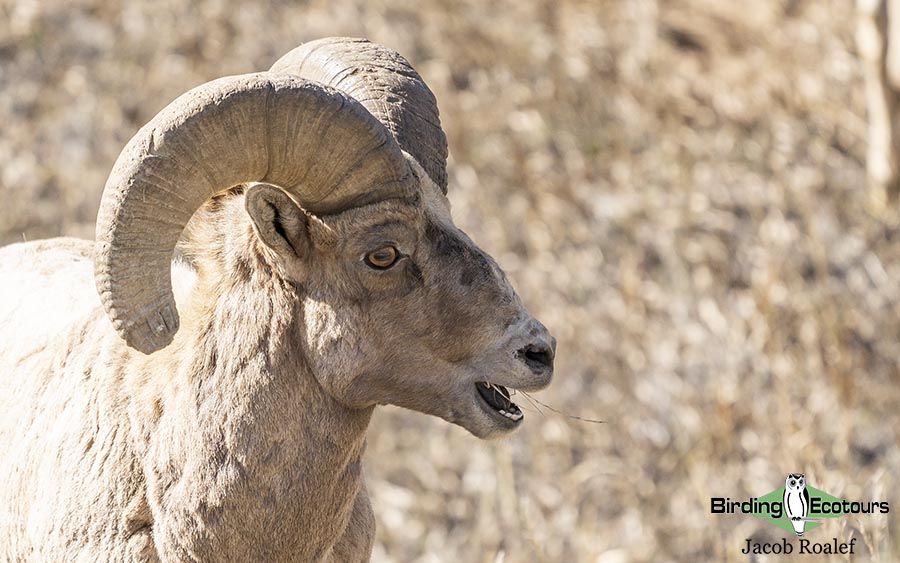
Day 8. Pueblo to Oakley
Now we leave behind the Front Range and enter the Eastern Plains, going all the way into Kansas with Oakley, Kansas being our final destination. First, we will drive through stellar grasslands with Prairie Falcon, Swainson’s and Ferruginous Hawks and Long-billed Curlew. A few planned stops near the town of Lamar will hopefully net us a few nice species such as Lark Sparrow, American Avocet, Snow Goose and American White Pelican. Finally, we will cross the state border and start ticking birds for our Kansas state list (if you’re into that sort of thing) before we settle in for the night in Oakley.
Overnight: Oakley, Kansas
Day 9. Lesser Prairie Chicken lek, Wray
This morning we will be up and at it early again, this time to get on site for the incredibly special Lesser Prairie Chicken leks. This species has been decreasing at an alarming rate but luckily a few populations are still maintaining in this area, and, with support from the local folks, hopefully they can begin increasing again. We may encounter other nice species while enjoying the leks including Horned Lark and Burrowing Owl. From here we will head north, back into Colorado. We may arrive in the Wray area with enough daylight to search the Wray State Fishing Unit for a variety of migrants and we may potentially hit the lekking area for a shot at Greater Prairie Chicken to hopefully enjoy their evening performance.
Overnight: Wray, Colorado
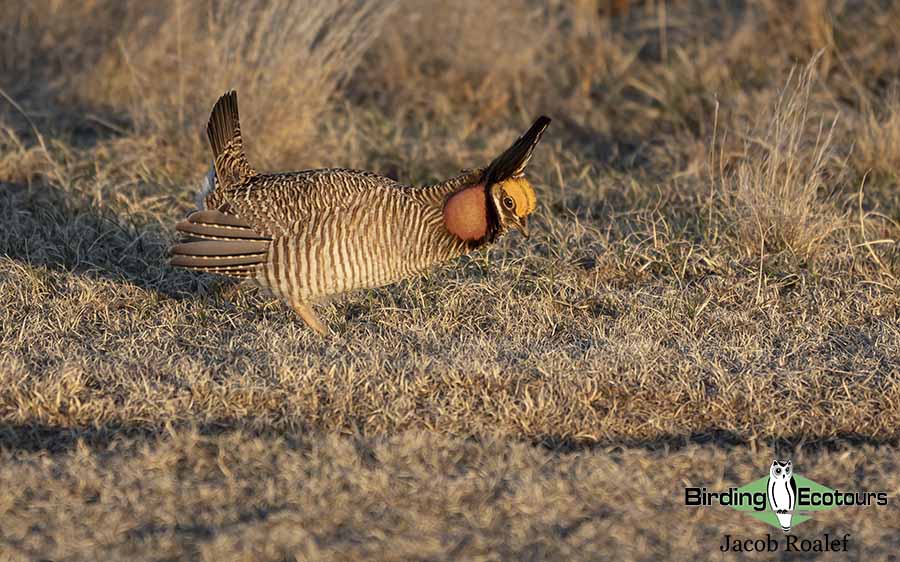
Day 10. Greater Prairie Chicken lek and Pawnee National Grasslands
This morning we will visit the Greater Prairie Chicken lek for another chance to see these amazing birds do their display. From here, we will head to the amazing habitat of Pawnee National Grasslands. This area of grassland is mixed with short buffalo grass, which is good for Thick-billed Longspur and Mountain Plover, and the taller grass for Chestnut-collared Longspur. There is also a possibility for Long-billed Curlew, a late Lapland Longspur or a flock of Sandhill Cranes. Ferruginous Hawk, Prairie Falcon, Say’s Phoebe, Burrowing Owl and Golden Eagle are often found here, and while traversing the rolling hills and prairie dog towns we’ll keep an eye out for Pronghorn (Antelope) too. Eventually we will call it quits and head back towards Denver and the airport.
Overnight: Denver, CO
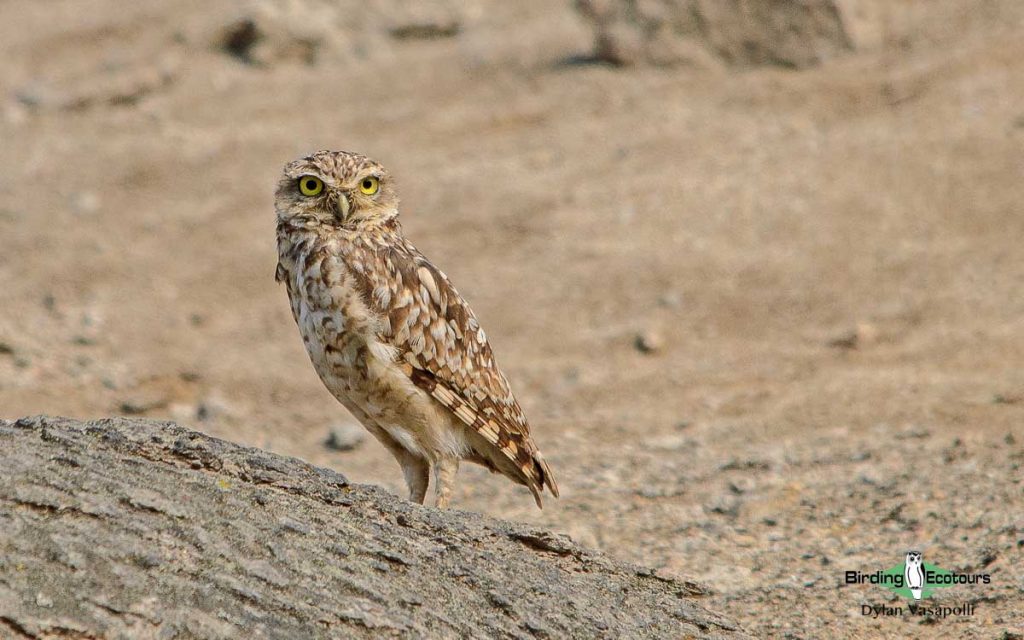
Day 11. Departure
Today marks the end of our journey. We will head to the airport for our departure and the conclusion of an amazing tour. To continue the fun, be sure to check out our Florida Peninsula and Specialties Tour which follows this one or perhaps you will enjoy our Texas Spring and Whooping Cranes Tour immediately preceding Colorado.
Please note that the itinerary cannot be guaranteed as it is only a rough guide and can be changed (usually slightly) due to factors such as availability of accommodation, updated information on the state of accommodation, roads, or birding sites, the discretion of the guides, and other factors. In addition, we sometimes have to use a different guide from the one advertised due to tour scheduling or other factors.
Download ItineraryUSA – Colorado: Set Departure Birding Trip Report
03 – 13 APRIL 2022
By Jacob Roalef
DOWNLOAD TRIP REPORT
Overview
This eleven-day set departure birding tour of Colorado commenced in Denver, Colorado on the 3rd of April 2022 and concluded back in Denver on the 13th of April 2022. The tour circled the state of Colorado and also had short stints to Kansas and Utah. We visited many fantastic birding locations such as Rocky Mountain Arsenal National Wildlife Refuge (NWR), Bledsoe Cattle Ranch, Abel Ranch, Wildernest community, Mt Crested Butte, Black Canyon of the Gunnison, Colorado National Monument and Genesee Park.
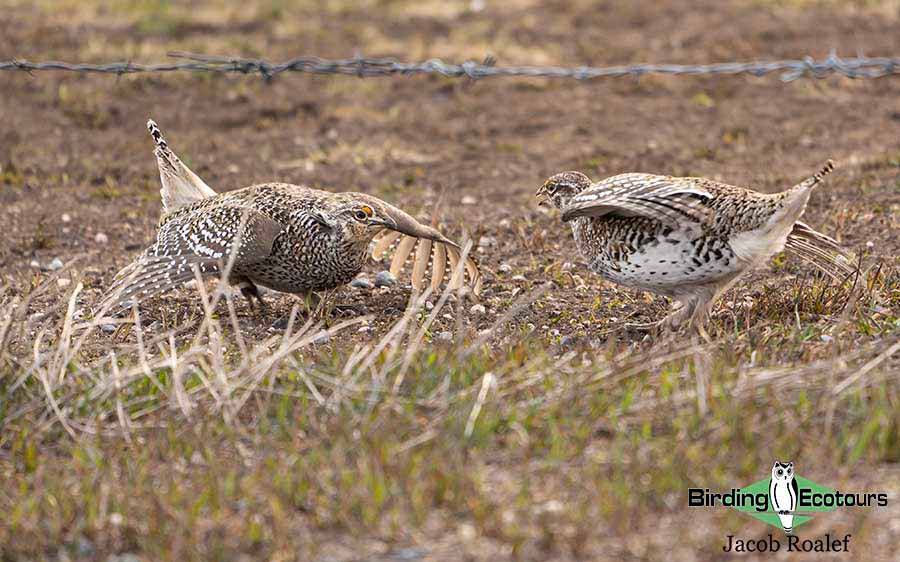
Sharp-tailed Grouse was the overall favorite species of the trip!
This tour connected with amazing target birds, including several of the game bird species such as Gunnison, Sharp-tailed and Dusky Grouse and Greater and Lesser Prairie-Chickens. Other great avian species seen were White-throated Swift, Western and Clark’s Grebes, Mountain Plover, Golden Eagle, Ferruginous Hawk, Lewis’s Woodpecker, Pinyon Jay, Juniper Titmouse, Canyon Wren, American Dipper, Sage Thrasher, Chestnut-collared and Thick-billed Longspurs and all three rosy finch species, Black, Grey-crowned, and Brown-capped Rosy Finches. We also managed to score a rarity for the lower 48 states in the form of a Yellow-billed Loon.
A total of 143 bird species were seen on this trip with none recorded as heard only. In addition to the birds, some fantastic mammals were spotted including Yellow-bellied Marmot, Gunnison’s Prairie Dog, Elk, Bighorn Sheep, Pronghorn and American Bison. Full bird and mammal checklists can be found at the end of the report.
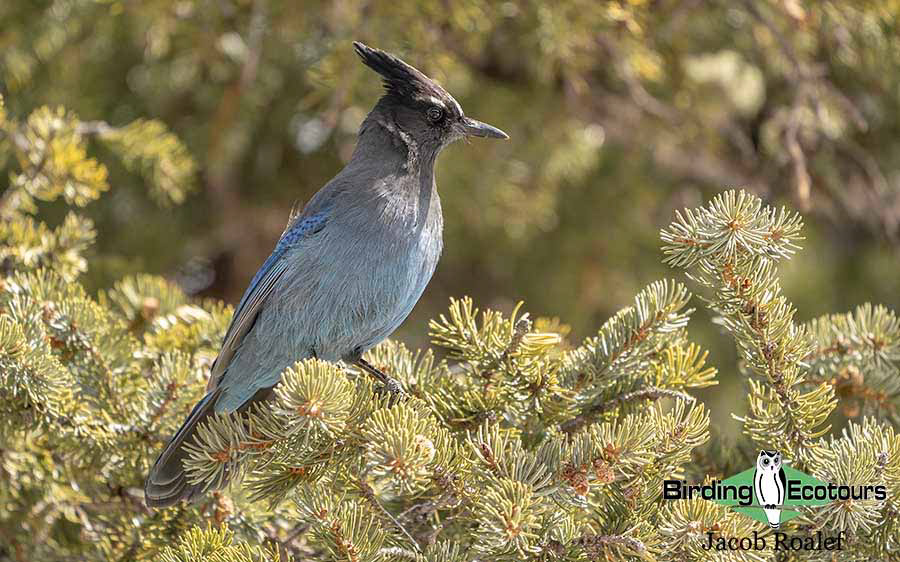
This striking Steller’s Jay was found in the high elevations of the Rockies.
Detailed Report
Day 1, 3rd April 2022. Arrival in Denver and transfer to Pueblo
Today marked the beginning of a great adventure. Four of the six participants managed to squeeze in some birding at the nearby Rocky Mountain Arsenal NWR while waiting for the others’ flights to arrive. Things were very birdy for a cloudy and chilly day in Denver. We picked up several ducks including American Wigeon, Northern Shoveler, Gadwall, Hooded Merganser and Common Goldeneye. We also really enjoyed a pair of Franklin’s Gulls in their pink-hued breeding plumage.
After we gathered up the rest of the group, we headed south towards Pueblo. Along the drive we scored Bald Eagle, Turkey Vulture and Red-tailed Hawk. It began to drizzle a bit and the clouds were looking dark, but we decided to make one quick birding stop along the way to check some farm fields that were covered in Cholla. After a decent search in some chilly and wet conditions we finally pulled out three Mountain Plovers, a fantastic sighting anytime, especially day one! Along with the plovers, we scored a nice Burrowing Owl and then, while we were driving out, a gorgeous Golden Eagle perched on a telephone pole. We made it to Pueblo for a tasty dinner and discussed the plans for the next few days before heading to the hotel to rest.
Day 2, 4th April 2022. Pueblo to Oakley, Kansas
After some breakfast, we headed off to a small neighborhood west of Pueblo to begin our first full day of birding. The rain held off as we cruised the streets, locating several nice species in the arid grassland habitat, including Say’s Phoebe, Curve-billed Thrasher and Canyon Towhee. A few Black-tailed Prairie Dogs were hanging out in someone’s backyard along with a Common Raven. We headed to Lake Pueblo State Park to do some scanning for waterbirds, and we were not disappointed. Right away we were on a Common Loon, along with Horned Grebe, American Coot and Northern Shoveler. After a bit of scanning, we spotted a true rarity, Yellow-billed Loon! This bird tested our patience as it was constantly up and down, diving in the water and covering a lot of area. Eventually, we all managed to get some nice scope views of this bird. Other species around the area included Townsend’s Solitaire, Western Grebe, Common Merganser, Western Osprey and a Rock Wren singing in the distance. Just before we packed up to leave, we got onto another loon in the distance, only this time it was a Pacific Loon! An incredible stop in Colorado with three loon species. We continued to another section of the park, labeled as the gravel pit and this small body of water was loaded with birds. We spent some time scanning through everything and picking out many species such as Snowy Egret, California and Bonaparte’s Gulls, Cinnamon Teal, Hooded Merganser, Wood Duck, American Avocet and Lesser Yellowlegs. While walking to and from the water we noted some nice forest birds as well like Black-capped Chickadee, Bushtit and House Wren.
From here we continued our way towards Kansas, with a couple of quick stops at reservoirs along the way. First up was Holbrook Reservoir where we scanned the water while enjoying a picnic-style lunch. This place was loaded with waterbird species, including Black-necked Stilt, Long-billed Dowitcher, Northern Shoveler and Double-crested Cormorant. After lunch we ventured onwards to Neenoshe Reservoir. The wind was really starting to pick up, a theme for the next few days, unfortunately. Between the large waves on the water, we managed to spot about 40 American White Pelicans as well as close swimming Clark’s Grebe. We kept driving and finally made it into Kansas where we came across our first Rough-legged Buzzard (Hawk) of the trip. We grabbed some dinner and went to our hotel in Oakley.
Day 3, 5th April 2022. Prairie-Chicken Lek and over to Wray
Getting up and out of the hotel before 5am, in cold and windy conditions, isn’t usually the easiest thing, but today it was no problem because we were all excited for our first lek of the trip! We met up with Jim and followed along to a private ranch where he had converted an old trailer into a bird blind. Once we were settled in, we waited for the sun to rise and the star birds to appear. With the first glimmer of light, we could make out the silhouettes of the Lesser Prairie Chickens on lek here in Kansas. We watched on in awe as they boomed and danced for us. Amazingly, a couple of Greater Prairie-Chickens were also visiting this lek, a little bit removed from the lesser in their own area. It was incredible to see both species close up next to each other for easy comparison! It was an absolutely perfect morning, followed up with coffee and warm breakfast. We then packed our things and heading out of Kansas.

The booming Greater Prairie-Chicken was a real treat to see.
The remainder of the day was mostly spent driving, in the now very windy conditions, towards Wray, Colorado and the Bledsoe Ranch to meet up with the owner, Bob. We stopped along the road at a small pool of water and noted a few new species including Long-billed Curlew and Savanah Sparrow. We eventually met up with Bob and listened to his stories and interesting history of the ranch, before heading out into the field to see the lekking location we were to visit the following morning. Amazingly, Bob pointed out a Great Horned Owl in what seemed like the only tree in the fields. We could barely make out the ear tufts in the tree cavity. After saying goodbye to Bob, we headed for dinner and sleep in preparation for our early morning the following day.
Day 4, 6th April 2022. More chickens, Pawnee National Grasslands, and back to Denver
This morning was another early start, as we needed to be in position at the lek before sunrise so we wouldn’t spook the birds. After navigating the various gates and dark farm lanes, we arrived at our position. It didn’t take long before our van was completely surrounded by booming Greater Prairie-Chickens! Everywhere we turned, there was another male showing off and strutting his stuff. A few females would come by and do some window shopping before presumably moving on to another lek on the ranch. We waited until the birds had finished their displaying before heading off. We stopped in a nearby field and managed to flush out three Northern Bobwhites, but relocating them after they landed in the tall grass was impossible. The wind was really howling now with gusts up to 60mph (95km/h). Any smart bird would be seeking cover and protection at this point. We had some coffee and tasty breakfast before packing our things and hitting the road.
The extreme wind certainly made our long drive more difficult, and birding was a real challenge. We made it to the Pawnee National Grasslands after lunch and cruised the roads. The only problem was that most birds were hunkered down, so finding anything was like pulling teeth. However, with our determination (and a little bit of luck) we managed to get great views of a few Thick-billed Longspurs foraging on the ground. Then with more determination (and a little less luck) we spotted a Chestnut-collared Longspur, but it only gave brief views to a few of us in the van. Our efforts to get out and bird were futile, as the second anyone stepped out, a hat would go flying and land about 100 yards away across the field. On our way out of the grasslands, we did get views of a Sage Thrasher on some barbed wire fencing. Despite the poor conditions, we still managed several nice species before heading back to Denver for the night.
Day 5, 7th April 2022. Denver to Gunnison, through the mountains
The first loop of the tour was complete and today marked the beginning of the second loop, covering the western portion of Colorado. We started through the Rocky Mountains, where we climbed in altitude and made a stop in Loveland Pass. Unfortunately, the conditions up there were absolutely brutal, with freezing temperatures and blistering winds making birding nearly impossible. We didn’t stay long and instead headed to the town of Silverthorne, which was slightly more protected. Here we stopped at a small local pond that wasn’t frozen and noted a few ducks including American Wigeon, Common and Barrow’s Goldeneye and Ring-necked Duck. We continued through the neighborhoods searching out feeders and any activity we could find. Eventually we discovered a small feeder setup which was busy with birds coming in and out. We had our first taste of finches with Grey-crowned and Brown-capped Rosy Finches, Red Crossbill and Pine Siskin all making visits. In addition to the finches, we noted other species in the neighborhood including Mountain Bluebird, Mountain Chickadee, Pygmy Nuthatch and Dark-eyed Junco.
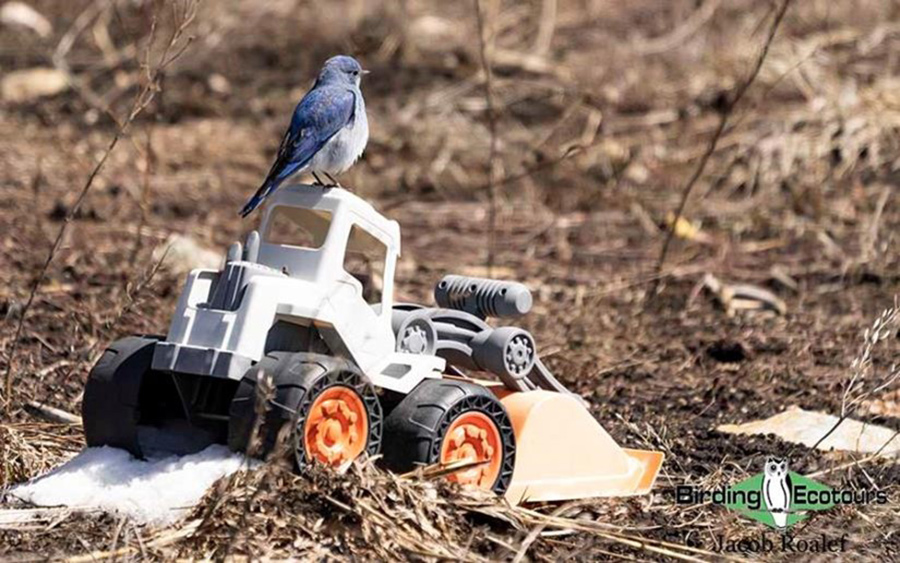
This Mountain Bluebird was perched up nicely on a toy truck.
We continued our long journey of the day, down the mountains towards Gunnison. After lunch we made stops in the towns of Buena Vista and Salida. It took some time and wandering through a neighborhood, but eventually we found our target, Lewis’s Woodpecker. This green gem was a real treat to see and had just arrived on breeding territory. Additionally, during our visit we picked up Clark’s Nutcracker, Hairy Woodpecker, Woodhouse’s Scrub Jay and White-breasted Nuthatch. From here we wound our way out of the mountains and eventually arrived in Gunnison for dinner, enjoying the amazing scenery along the way.
Day 6, 8th April 2022. Early lek and Mt Crested Butte
Today was probably our earliest start yet as we headed off for another lek, well before sunrise. Unfortunately, due to the current Endangered status [IUCN], viewing Gunnison Grouse leks needs to be done from a safe distance so as not to disturb the birds. We waited until ample light was available and managed some fine scope views of this amazing species, head bobbing and booming in the distance. This was certainly worth the early morning rise. From here we headed off for a much-deserved breakfast and coffee before heading up to Mt Crested Butte, a small ski town in southern Colorado. On our way up, we made a quick stop at a small bridge crossing over some fast-moving water and enjoyed views of a pair of American Dippers, a real star bird. We even heard them singing every once in a while! Up on top of the mountain, we cruised the neighborhoods searching for feeders and wandering flocks. Here we managed to get on a big flock of rosy finches which were mainly made up of Brown-capped Rosy Finches with a couple of Grey-crowned Rosy Finches. After speaking with a local and observing the finches for a while, we headed off to the area we thought might have another feeder. As soon as we pulled over, there was a Black Rosy Finch on the ground right next to the car! This bird was incredibly tame, allowing all of us to get amazing views and pictures. At one point it was picking grit under the vehicle! In addition to the rosy finches, we managed to see some other nice species such as Northern Flicker, Steller’s Jay, Mountain Bluebird and Cassin’s Finch.
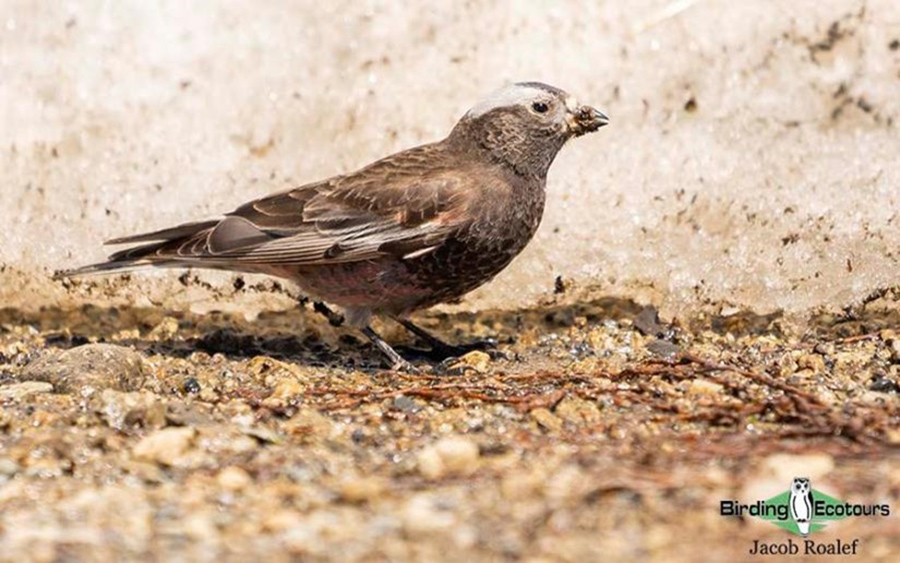
This Black Rosy-Finch put on quite a show for us.
We enjoyed a tasty lunch in this lovely town before making our way back down the mountain towards Gunnison. The afternoon was spent at Roaring Judy Fish Hatchery, where we enjoyed a lovely hike around the ponds and picked up several great species including Wilson’s Snipe, Cinnamon Teal, Osprey, Bald Eagle and Song Sparrow. We continued onwards and spent some time at the McCabe wetlands which produced Tree Swallow, Green-winged Teal, Spotted Towhee and another American Dipper. It was then time for dinner and some much-needed rest.
Day 7, 9th April 2022. Black Canyon of the Gunnison and over to Grand Junction
This morning was a normal start time for once, so we loaded up our van, grabbed some breakfast and hit the road. Our first stop was the campground at Black Canyon of the Gunnison NP, where we spent some time walking the empty roads and camping spots, which were still covered in snow. A beautiful Slate-colored Fox Sparrow showed long enough for the whole group to eventually see. The area was rather quiet with only a few other species showing off, such as Woodhouse’s Scrub-Jay, Cassin’s Finch and Spotted Towhee. We did however enjoy some beautiful scenery and nice weather while we were there. We continued our drive towards Grand Junction with a few stops at some local bodies of water in Delta. Things were a bit flatter in this area and as such, the wind started picking up again. Fortunately, we did manage to get nice views of Western Grebe before moving on through Grand Mesa.
A quick restroom break yielded some very curious Steller’s and Canada Jays. We enjoyed watching these clever birds eat some snacks that had fallen out of another vehicle (maybe it was deliberate to feed the birds…) We continued up through this mountainous region and spent some time at the Powderhorn Ski Resort, a ghost town for now because the skiing season was over. We managed to get into a nice mixed flock with Red-naped Sapsucker, Wild Turkey and Red-winged Blackbird as the highlights. While finishing our drive, we picked up Black Phoebe and White-throated Swift before making it to Grand Junction for the evening.
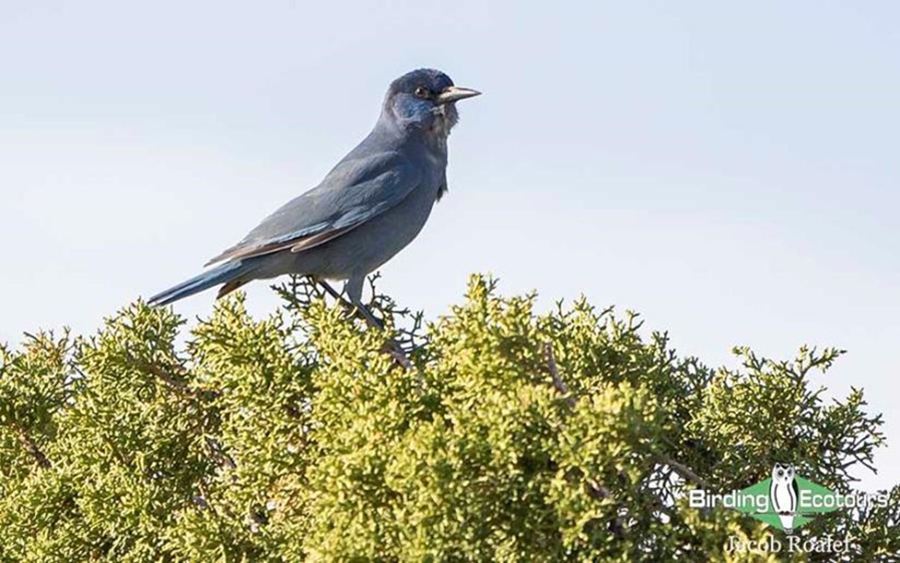
A Pinyon Jay perched up nicely for the group to enjoy before flying off.
Day 8, 10th April 2022. Colorado National Monument to Steamboat Springs
We set off early this morning with a lot of distance to cover and birding to do. First up was a small neighborhood outside of Colorado National Monument, where we picked up on a lovely Western Bluebird in the morning light, as well as a small covey of Gambel’s Quail. We continued on to some of the scenic overlooks and scanned the nearby Juniper trees and distant cliffs. Way off in the distance was a Peregrine Falcon perched on the rocky outcrop, as well as a Golden Eagle waiting for the sunlight to heat up the air, so they could begin hunting. As we scanned, a very curious and adorable Canyon Wren belted off a song almost under our feet and gave us some lovely views. On our way out, we heard the calls of a small flock of Pinyon Jays, and it wasn’t long before we spotted them and enjoyed their gorgeous color along with a noisy Bewick’s Wren in the nearby scrub. Along our next stop, we scoured the trees until we found a nice group of birds which included Juniper Titmouse, Ruby-crowned Kinglet and Bushtit.
From here we grabbed some coffee and headed west to the Utah/Colorado boarder to some great sagebrush habitat. It was here that we scored a nice Sagebrush Sparrow (technically in Utah) although it didn’t perch up close or for very long. Our last stop of the day was the Cameo and Coal Canyon which also doubles as a shooting range. Bad luck for us, some sort of competition was going on making birding very difficult. We still managed to find a few nice birds such as Black-throated and White-crowned Sparrows and Rock Wren. We finished the long drive to Steamboat Springs and checked into the hotel where we would spend the next two nights.
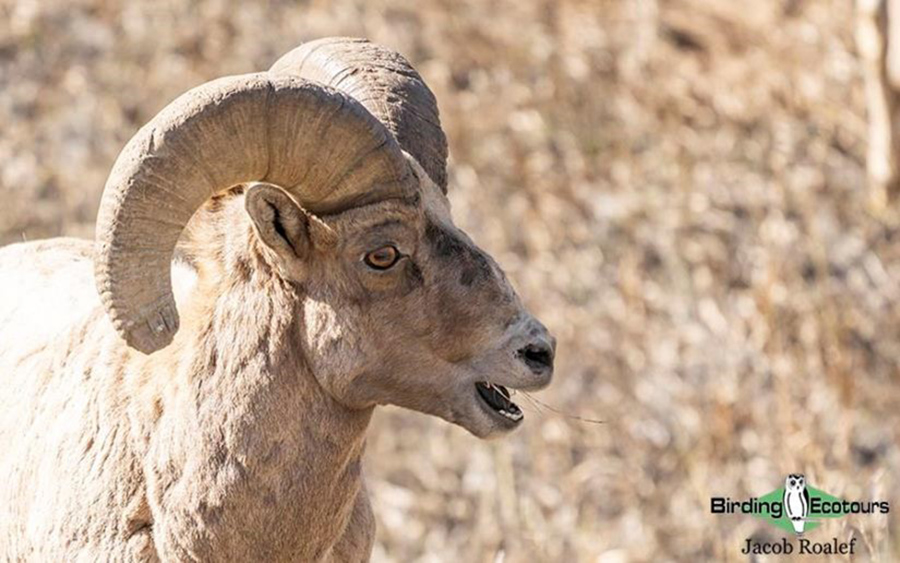
Bighorn Sheep were one of several mammal species enjoyed by our group.
Day 9, 11th April 2022. Early lek near Steamboat Springs
Another early morning, another lek. This time we set off towards Hayden and in the dark of the night, a Dusky Grouse almost ended up being roadkill! Unfortunately, only a couple of us managed a visual before it took off. We made it to the lekking area for the Sharp-tailed Grouse but there were no birds to be seen. We waited until after the sun rose before deciding that these birds must have been spooked off the site early, so we ventured out in search of them. It wasn’t much further up the road where we spotted a few birds in a field, which were then flushed and one landed in the top of a tree! We all managed scope views before getting a bit closer. Eventually, we got onto two displaying males right along the road with a few females watching nearby. We observed these birds from the safety and blind of our van from a super close distance and even watched as they passed right in front of the vehicle! These Sharp-tailed Grouse were certainly a highlight experience of the trip. We began the journey back to Steamboat Springs and along the way, out of the corner of my eye, I caught the silhouette of a very funny shaped bird with a long neck perched on a wire. At first, I thought it was a goose, so I pulled off safely to check this out, as a wire is a weird place for a goose to perch. Turns out it was not a goose but rather a Dusky Grouse!! Still a strange bird for a high wire, but we all managed a view of this one before it dropped down and out of sight. What a bizarre sighting that was.
Back in Steamboat Springs, we cruised around the neighborhoods, enjoying the view and architecture of some of the mansions there. We did see some birds as well and eventually found a mixed flock with Dark-eyed Junco, Evening Grosbeak, Pine Siskin and Red-breasted Nuthatch, as well as a Yellow-bellied Marmot off the road. We continued to some open farm fields in the Coalmont area, taking in some scenery and scanning for anything. Most of the birds were Horned Larks, but we did spot a few Golden Eagles and Mountain Bluebirds. On our way out we came across a stunning Ferruginous Hawk perched up on a snowbank. We watched it for a while until it flew off a bit and displayed even more of its beauty. This was a great way to end the day.
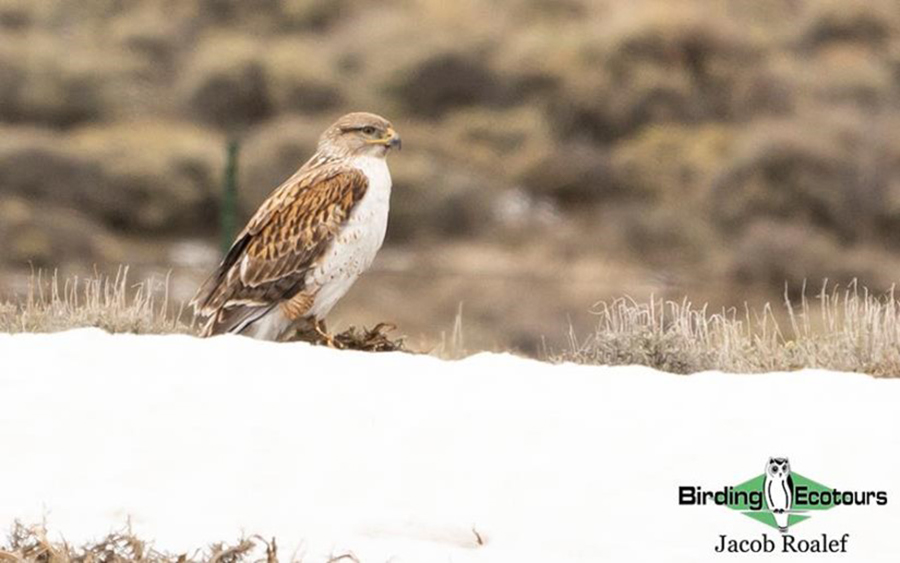
We were all ecstatic to catch up with this Ferruginous Hawk on one of the final days.
Day 10, 12th April 2022. Back to Denver through Silverthorne
Today we had high hopes of another lek but unfortunately the weather had other ideas. The forecast was calling for snow overnight and we started off in the morning well before sunrise. We were greeted with snow covered roads and poor visibility, not a great combination if planning to drive over the mountains. However, we were not deterred and set off slowly towards the lek, eventually getting behind a plow truck. It was going decently well until suddenly the plow swerved and got stuck in the snowbank on the side of the road. We were stuck behind the plow because they were blocking traffic and a large semi-truck was stuck in the opposite lane. There was nothing we could do and quite frankly, it was probably a good thing since the road conditions were not good. We waited for over two hours while the amazing Colorado emergency tows got everyone unstuck and on their way. Needless to say, no lek today and our main goal just to get back to Denver safely.
We took things slowly and conditions did improve enough to allow us time to stop for lunch back in Silverthorne. We checked out some more feeders in the area and got one last experience with all three rosy finch species, Black, Brown-capped and Grey Crowned Rosy Finches. It was an amazing sight to see approximately 200 rosy finches swirling through the air and coming into the feeders. Other birds included Mountain Bluebird, Cassin’s Finch and Evening Grosbeak. On the eastern side of the mountains, the weather was beautiful and clear. We made a stop at Genesee Park and enjoyed the weather as well as Downy Woodpecker, Say’s Phoebe and White-breasted Nuthatch. Although this day had not gone according to plan, it could have been much worse, and we were thankful for what we had achieved.
Day 11, 13th April 2022. Departure day with some final birding
After an early morning airport drop-off for some folks, a few others decided to venture out for another loop around the Rocky Mountain Arsenal NWR. It was a gorgeous morning to be out and although we didn’t see any new species for the trip, we did enjoy viewing some beautiful wildlife like Western Meadowlark, Red-tailed Hawk, American Bison and White-tailed Deer. We headed back to the hotel to gather our things and a few participants who had opted out of the morning birding, and then headed to the airport. I asked everyone what their top five birds of the trip were, a tough question with so many great species. After some discussion, the top five for the group, in no particular order, were Sharp-tailed Grouse, Black Rosy Finch, Greater Prairie-Chicken, Lesser Prairie-Chicken and Canyon Wren. This concluded a fantastic tour.

Quietly observing a Lesser Prairie-Chicken dancing was certainly a top highlight.
Bird List – Following IOC (12.1)
The following notation after species names is used to show conservation status following BirdLife International: CE = Critically Endangered, EN = Endangered, VU = Vulnerable, NT = Near Threatened.
| Common Name | Scientific Name |
| Ducks, Geese, Swans (Anatidae) | |
| Tundra Swan (Rarity) | Cygnus columbianus |
| Canada Goose | Branta canadensis |
| Wood Duck | Aix sponsa |
| Cinnamon Teal | Spatula cyanoptera |
| Northern Shoveler | Spatula clypeata |
| Gadwall | Mareca strepera |
| American Wigeon | Mareca americana |
| Mallard | Anas platyrhynchos |
| Northern Pintail | Anas acuta |
| Green-winged Teal | Anas crecca |
| Canvasback | Aythya valisineria |
| Redhead | Aythya americana |
| Ring-necked Duck | Aythya collaris |
| Greater Scaup | Aythya marila |
| Lesser Scaup | Aythya affinis |
| Bufflehead | Bucephala albeola |
| Common Goldeneye | Bucephala clangula |
| Barrow’s Goldeneye | Bucephala islandica |
| Hooded Merganser | Lophodytes cucullatus |
| Common Merganser | Mergus merganser |
| Ruddy Duck | Oxyura jamaicensis |
| New World Quail (Odontophoridae) | |
| Northern Bobwhite | Colinus virginianus |
| Gambel’s Quail | Callipepla gambelii |
| Pheasants & Allies (Phasianidae) | |
| Wild Turkey | Meleagris gallopavo |
| Gunnison Grouse (Endemic) – EN | Centrocercus minimus |
| Dusky Grouse | Dendragapus obscurus |
| Sharp-tailed Grouse | Tympanuchus phasianellus |
| Greater Prairie-Chicken | Tympanuchus cupido |
| Lesser Prairie-Chicken – VU | Tympanuchus pallidicinctus |
| Ring-necked Pheasant (Introduced) | Phasianus colchicus |
| Grebes (Podicipedidae) | |
| Horned Grebe – VU | Podiceps auritus |
| Eared Grebe | Podiceps nigricollis |
| Western Grebe | Aechmophorus occidentalis |
| Clark’s Grebe | Aechmophorus clarkii |
| Pigeons, Doves (Columbidae) | |
| Rock Pigeon (Introduced) | Columba livia |
| Eurasian Collared-Dove (Introduced) | Streptopelia decaocto |
| Mourning Dove | Zenaida macroura |
| Swifts (Apodidae) | |
| White-throated Swift | Aeronautes saxatalis |
| Rails, Crakes & Coots (Rallidae) | |
| American Coot | Fulica americana |
| Cranes (Gruidae) | |
| Sandhill Crane | Antigone canadensis |
| Stilts and Avocets (Recurvirostridae) | |
| Black-necked Stilt | Himantopus mexicanus |
| American Avocet | Recurvirostra americana |
| Plovers (Charadriidae) | |
| Killdeer | Charadrius vociferus |
| Mountain Plover | Charadrius montanus |
| Sandpipers, Snipes (Scolopacidae) | |
| Long-billed Curlew | Numenius americanus |
| Long-billed Dowitcher | Limnodromus scolopaceus |
| Wilson’s Snipe | Gallinago delicata |
| Lesser Yellowlegs | Tringa flavipes |
| Gulls, Terns, Skimmers (Laridae) | |
| Bonaparte’s Gull | Chroicocephalus philadelphia |
| Franklin’s Gull | Leucophaeus pipixcan |
| Ring-billed Gull | Larus delawarensis |
| California Gull | Larus californicus |
| American Herring Gull | Larus argentatus |
| Loons (Gaviidae) | |
| Common Loon | Gavia immer |
| Pacific Loon (Rarity) | Gavia pacifica |
| Yellow-billed Loon (Rarity) | Gavia adamsii |
| Cormorants and Shags (Phalacrocoracidae) | |
| Double-crested Cormorant | Nannopterum auritum |
| Pelicans (Pelecanidae) | |
| American White Pelican | Pelecanus erythrorhynchos |
| Herons, Bitterns (Ardeidae) | |
| Great Blue Heron | Nycticorax nycticorax |
| Snowy Egret | Egretta thula |
| Black-crowned Night-Heron | Nycticorax nycticorax |
| New World Vultures (Cathartidae) | |
| Turkey Vulture | Cathartes aura |
| Ospreys (Pandionidae) | |
| Western Osprey | Pandion haliaetus |
| Kites, Hawks, Eagles (Accipitridae) | |
| Golden Eagle | Aquila chrysaetos |
| Northern Harrier | Circus hudsonius |
| Cooper’s Hawk | Accipiter cooperii |
| Bald Eagle | Haliaeetus leucocephalus |
| Swainson’s Hawk | Buteo swainsoni |
| Red-tailed Hawk | Buteo jamaicensis |
| Rough-legged Buzzard (Hawk) | Buteo lagopus |
| Ferruginous Hawk | Buteo regalis |
| Owls (Strigidae) | |
| Great Horned Owl | Bubo virginianus |
| Burrowing Owl | Athene cunicularia |
| Woodpeckers (Picidae) | |
| Lewis’s Woodpecker | Melanerpes lewis |
| Red-naped Sapsucker | Sphyrapicus nuchalis |
| Downy Woodpecker | Dryobates pubescens |
| Hairy Woodpecker | Leuconotopicus villosus |
| Northern Flicker | Colaptes auratus |
| Caracaras, Falcons (Falconidae) | |
| American Kestrel | Falco sparverius |
| Peregrine Falcon | Falco peregrinus |
| Tyrant Flycatchers (Tyrannidae) | |
| Black Phoebe | Sayornis nigricans |
| Say’s Phoebe | Sayornis saya |
| Shrikes (Laniidae) | |
| Loggerhead Shrike | Lanius ludovicianus |
| Crows, Jays, and Magpies (Corvidae) | |
| Canada Jay | Perisoreus canadensis |
| Pinyon Jay – VU | Gymnorhinus cyanocephalus |
| Steller’s Jay | Cyanocitta stelleri |
| Blue Jay | Cyanocitta cristata |
| Woodhouse’s Scrub-Jay | Aphelocoma woodhouseii |
| Black-billed Magpie | Pica hudsonia |
| Clark’s Nutcracker | Nucifraga columbiana |
| American Crow | Corvus brachyrhynchos |
| Northern (Common) Raven | Corvus corax |
| Tits, Chickadees, and Titmice (Paridae) | |
| Black-capped Chickadee | Poecile atricapillus |
| Mountain Chickadee | Poecile gambeli |
| Juniper Titmouse | Baeolophus ridgwayi |
| Larks (Alaudidae) | |
| Horned Lark | Eremophila alpestris |
| Swallows (Hirundinidae) | |
| Tree Swallow | Tachycineta bicolor |
| Barn Swallow | Hirundo rustica |
| Long-tailed Tits (Aegithalidae) | |
| Bushtit | Psaltriparus minimus |
| Kinglets (Regulidae) | |
| Ruby-crowned Kinglet | Corthylio calendula |
| Nuthatches (Sittidae) | |
| Red-breasted Nuthatch | Sitta canadensis |
| White-breasted Nuthatch | Sitta carolinensis |
| Pygmy Nuthatch | Sitta pygmaea |
| Wrens (Troglodytidae) | |
| Rock Wren | Salpinctes obsoletus |
| Canyon Wren | Catherpes mexicanus |
| House Wren | Troglodytes aedon |
| Bewick’s Wren | Thryomanes bewickii |
| Dippers (Cinclidae) | |
| American Dipper | Cinclus mexicanus |
| Mockingbirds, Thrashers (Mimidae) | |
| Curve-billed Thrasher | Toxostoma curvirostre |
| Sage Thrasher | Oreoscoptes montanus |
| Starlings, Rhabdornis (Sturnidae) | |
| Common (European) Starling (Introduced) | Acridotheres tristis |
| Thrushes (Turdidae) | |
| Western Bluebird | Sialia mexicana |
| Mountain Bluebird | Sialia currucoides |
| Townsend’s Solitaire | Myadestes townsendi |
| American Robin | Turdus migratorius |
| Old World Sparrows (Passeridae) | |
| House Sparrow (Introduced) | Passer domesticus |
| Finches, Euphonias (Fringillidae) | |
| Evening Grosbeak – VU | Coccothraustes vespertinus |
| Gray-crowned Rosy-Finch | Leucosticte tephrocotis |
| Black Rosy-Finch – EN | Leucosticte atrata |
| Brown-capped Rosy-Finch – EN | Leucosticte australis |
| House Finch | Haemorhous mexicanus |
| Cassin’s Finch | Haemorhous cassinii |
| Red Crossbill | Loxia curvirostra |
| Pine Siskin | Spinus pinus |
| Longspurs and Snow Buntings (Calcariidae) | |
| Chestnut-collared Longspur – VU | Calcarius ornatus |
| Thick-billed Longspur | Rhynchophanes mccownii |
| New World Sparrows (Passerellidae) | |
| Chipping Sparrow | Spizella passerina |
| Slate-colored Fox Sparrow | Passerella schistacea |
| Dark-eyed Junco | Junco hyemalis |
| White-crowned Sparrow | Zonotrichia leucophrys |
| Sagebrush Sparrow | Artemisiospiza nevadensis |
| Savannah Sparrow | Passerculus sandwichensis |
| Song Sparrow | Melospiza melodia |
| Canyon Towhee | Melozone fusca |
| Spotted Towhee | Pipilo maculatus |
| Oropendolas, Orioles, Blackbirds (Icteridae) | |
| Western Meadowlark | Sturnella neglecta |
| Red-winged Blackbird | Agelaius phoeniceus |
| Brown-headed Cowbird | Molothrus ater |
| Brewer’s Blackbird | Euphagus cyanocephalus |
| Common Grackle | Quiscalus quiscula |
| Great-tailed Grackle | Quiscalus mexicanus |
| New World Warblers (Parulidae) | |
| Myrtle (Yellow-rumped) Warbler | Setophaga coronata |
| Audubon’s (Yellow-rumped) Warbler | Setophaga auduboni |
| Total Seen | 143 |
| Total Heard | 0 |
| Total Recorded | 143 |
Mammal List
| Common Name | Scientific Name |
| Rabbits and Hares (Leporidae) | |
| Eastern Cottontail | Sylvilagus floridanus |
| Mountain Cottontail | Sylvilagus nuttallii |
| Black-tailed Jackrabbit | Lepus californicus |
| Squirrels and Allies (Sciuridae) | |
| Bryant’s Fox Squirrel | Sciurus niger |
| Colorado Chipmunk | Neotamias quadrivittatus |
| Nevada Ground Squirrel | Urocitellus elegans |
| Rock Squirrel | Otospermophilus variegatus |
| Yellow-bellied Marmot | Marmota flaviventris |
| Gunnison’s Prairie Dog | Cynomys gunnisoni |
| Black-tailed Prairie Dog | Cynomys ludovicianus |
| Dogs (Canidae) | |
| Coyote | Canis latrans |
| True Deer (Cervidae) | |
| Elk | Cervus canadensis |
| Mule Deer | Odocoileus hemionus |
| White-tailed Deer | Odocoileus virginianus |
| Cloven-hoofed Mammals (Bovidae) | |
| Bighorn Sheep | Ovis canadensis |
| American Bison | Bison bison |
| Pronghorn (Antilocapridae) | |
| Pronghorn | Antilocapra americana |
| Total seen | 17 |
DOWNLOAD TRIP REPORT
Please see the downloadable PDF above with the full species lists included. This is a sample trip report. Please email us ([email protected]) for more trip reports from this destination.
USA: Colorado – Lekking Grouse and Rocky Mountains
Tour-specific Information
PASSPORT AND VISA
For US citizens, no visas or passports are required. You will need to bring along a government-issued ID as they are sometimes required for hotels.
Non-United States citizens will require a valid passport to enter the country, and some may require a tourist visa. Please consult with your local US Embassy for more details and information. You may need to show your ID/passport at various hotels or for the boat departures on this tour.
TRAVEL INSURANCE
We strongly encourage you to purchase trip cancellation or interruption insurance in case you have to cancel due to illness or for any other reason, as tour payments are non-refundable as per our terms and conditions. We advise you to get a plan which covers all your medical care and evacuation back to your country of residence, repatriation, and trip cancellation due to illness just prior, or any other reason.
HEALTH
Colorado does not pose any major health risks, aside from high altitudes on a few days. On one day of the tour we will be at approximately 12,000 ft (3,650 m), which we will be reaching by vehicle. Typically, this involves scanning from fixed positions with minimal walking in the snow. Ample water and layers will help combat this elevation and we will be sure to increase our altitude at a slow pace. Water will be available throughout the tour and please feel free to bring your own reusable bottle to refill throughout the tour as the tap water here is safe.
MEDICAL CONDITIONS
Please make sure that you are covered by medical insurance in case of an emergency while on this trip. Without insurance the cost of medical care can be extremely high. Please notify us, at the time of registering for this tour, of any medical conditions you think we should know about (including allergies, heart conditions, epilepsy, etc.). This will greatly help us to cater to your needs and update emergency services if required.
WEATHER/CLIMATE
The weather in Colorado in April can vary drastically from 70 °F (21 °C) down to 20 °F (-7 °C). Conditions can vary from heavy snow to beautiful sunny weather and sometimes these changes can occur in only a few hours, especially as we change in elevation. Layers and warm clothing options are a must to help with the wide range of conditions. Early mornings at lekking sites can be especially cold as we wait patiently without much movement and before the sun rises. Waterproof and rain gear are essential to ensure comfort while on the tour as it can rain or snow at any time.
ACCOMMODATION
We will be staying at comfortable hotels throughout the tour.
COMMUNICATIONS
Our hotels should have decent access to Wi-Fi throughout the trip and phone service is typically fine near these areas and in the larger more populated cities. There are times throughout the trip where we will be out in the wilderness and higher altitudes so do expect to lose coverage at some points.
PHYSICAL REQUIREMENTS AND PACE OF TOUR
There are several very early starts on this tour (4:30 am) in order to get to lekking areas before sunrise. We will have something light to eat and head out to the lek where we will be viewing either from the van or a blind. Once we begin, we will not be able to leave or get out of these areas and we must remain as still and quiet as possible.
After the lek is complete, we will have a fuller breakfast and gather our luggage/gear and proceed with the day. There is also a lot of driving involved with this tour as we are covering a huge amount of ground, but of course there will be birding stops along the way, to help break up the drives. Hiking/walking requirements are relatively easy and done either along the road or well-maintained trails and typically less than a mile (1.6 kilometers) at a time. Keep in mind that while the distance and pace of walking is mild, we will be at higher altitudes at times.
WHAT TO BRING
Please kindly read the general list of what to bring on a birding tour, here.
Layers and waterproof gear are always a good idea when preparing for a wide variety of possible weather conditions, and we consider them essential on this tour. We also do recommend bringing Dramamine or other motion sickness medications if you need them, as there are long drives in the vehicle. Also, please bring along a face mask (or a few) to ensure we are able to follow local guidelines during the Covid-19 pandemic, as they will be required in certain areas.
Do not forget – Binoculars, prescription drugs (also bring the generic names for these drugs), toiletries, prescription glasses (and a spare pair), sunglasses, camera, batteries (for electronic equipment and chargers for re-chargeable batteries if required), alarm clock, money pouch, field guide(s), daypack.
Key documents and cash – Passports, your travel or health insurance cards, photocopies of which can be carried by the tour leader in case of emergency, Covid-19 vaccine card (or photo/copy), credit cards. US dollars for drinks, gifts, tips, items of a personal nature, etc., which are not included in the tour cost.
LUGGAGE
There should be enough space for each participant to bring one medium-sized suitcase as well as a personal bag to keep at their seat with them. Please do be mindful with large cameras or tripods if you choose to bring these along.
Download Colorado: Lekking Grouse and Rocky Mountains Information
‘If you want to see great views of Chickens and Grouse at their leks, then this is the tour for you. Early mornings are no problem when you experience up-close views of these magnificent birds.
Don’t forget the other birds found in Colorado, this tour goes out of its way to find them all – and it doesn’t disappoint.’
Barbara

